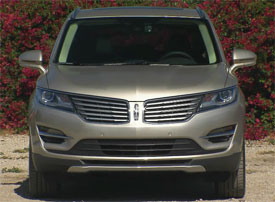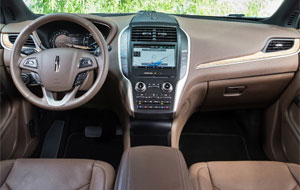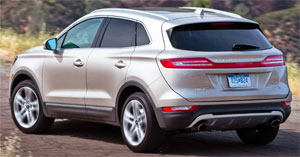2015 Lincoln MKC
The newest target for the crossover craze is small luxury utilities. Auto makers can’t seem to bring them to the market fast enough to satisfy a public hungry for luxury in a small yet versatile package. The most recent brand to plunge into the mix is Lincoln, with the compact MKC. Let’s see if this latest Lincoln can help the brand “escape” their current also-ran status and head back to prominence.
With their last few all-new vehicle launches, Lincoln has made a big deal about that particular model being the one to reverse a decline in sales and image. Well indeed, things are finally starting to look up this year on both counts and their latest, this 2015 MKC will certainly help further the cause.
This compact, premium utility is without a doubt the right vehicle at the right time; as small luxury utes are springing up everywhere, and people are just as eagerly snatching them up. And it doesn’t take much time behind the wheel to discover that being incredibly quiet and ultra-comfortable were clear priorities in this design. Long distance cruising is where the MKC’s ride really shines.
 Lincoln Drive Control includes Continuously Controlled Damping and the usual Comfort, Normal, and Sport modes to tailor your driving experience. Perhaps surprisingly, handling is on par with its primary European rivals, yet the ride remains smooth and controlled no matter the drive mode setting.
Lincoln Drive Control includes Continuously Controlled Damping and the usual Comfort, Normal, and Sport modes to tailor your driving experience. Perhaps surprisingly, handling is on par with its primary European rivals, yet the ride remains smooth and controlled no matter the drive mode setting.
It’s all turbo-4, all the time, under the hood of the MKC. You choose whether you want the boost coming from the Escape’s 240-horsepower 2.0-liter EcoBoost or a new 2.3-liter EcoBoost that outputs 285-horsepower and 305 lb-ft. of torque.
We spent all of our early drive time around Santa Barbara, California in a 2.3 and found it to be super torque-y feeling and spirited around town. But once the roads got more interesting, it and the 6-speed automatic transmission didn’t always seem to be on the same page, as there was occasional hunting for gears and power. All-wheel-drive is standard with the 2.3 and available on the 2.0. Torque Vectoring Control is standard on all.
Lincoln didn’t release a 0-60 time, but the 2.3 should just best the Escape 2.0s 7.0-seconds. Towing capacity is actually greater with the 2.0-liter, but at 3,000-pounds it’s still rated 500-pounds less than in the Escape.
Like the MKZ sedan, the trans is controlled by push buttons on the dash. It works fine, unless you’re in a hurry doing 3-point turns, as there is some lag time between Drive and Reverse.
 It’s lux to the max inside, as most materials are both good to look at and touch. With the possible exception of the center stack, where function appears to overcome form. But kudos to Lincoln for actually adding buttons and knobs to the Sync with MyLincoln Touch interface.
It’s lux to the max inside, as most materials are both good to look at and touch. With the possible exception of the center stack, where function appears to overcome form. But kudos to Lincoln for actually adding buttons and knobs to the Sync with MyLincoln Touch interface.
Front seats are large and comfortable and just about every current tech feature you can think of is available. Rear seats are equally comfortable and the space is pretty roomy for a compact. As for storage, cargo volume is also less than the Escape at 25.2 cubic-ft. behind the 2nd row, expanding to 53.1 cubic-ft with the standard 60/40 split-folding seat backs lowered.
Wow factor features include an epic panorama Vista Roof, and approach detection with cool but gimmicky welcome mat lighting.
The same can be said about the highly sculpted exterior. It looks cool and very athletic, yet also a little attention-seeking.
The MKC obviously shares the Ford Escape’s chassis, but body panels are more smooth and classy than edgy. Upper bodylines are reminiscent of the Hyundai Santa Fe. Out back, the full width tail lights and unique wraparound lift gate give the appearance of a road-going, art deco toaster.
The retro split winged grille is back, and here less objectionable, though none of our crew appreciated the tired 90’s gray cladding that encircles the MKC.
Taking self-parking to the next level is Park Out Assist which helps guide the driver out of tight parallel parking situations.
 Government Fuel Economy Ratings for the 2.3 are 18-City, 26-Highway, and 21-Combined with Regular gas. Making the Energy Impact Score very much average for all vehicles at 15.7-barrels of annual oil consumption with CO2 emissions of 7.0-tons.
Government Fuel Economy Ratings for the 2.3 are 18-City, 26-Highway, and 21-Combined with Regular gas. Making the Energy Impact Score very much average for all vehicles at 15.7-barrels of annual oil consumption with CO2 emissions of 7.0-tons.
Base pricing of $33,995 is probably the best news yet, as that is significantly less than most rivals. But stepping up to the 2.3-liter requires a more considerable investment. Technically, it’s only about 11-hundred dollars more, but as for now, Lincoln requires you to also step up to Select trim, which brings your total to $40,860.
And that’s where things get muddled for the entire small luxury crossover segment. When you hit that 40K mark, there are quite a few larger options out there. Still, among its smallish peers, the 2015 Lincoln MKC stacks up well as it is a very nimble, well-crafted piece. And, it will certainly do its part on putting the Lincoln brand back on track.
Specifications
- Horsepower: 285
- Engine: 2.3-liter
- Torque: 305 lb-ft.
- 0-60 mph: 6.8 seconds est.
- EPA: 18 mpg city/ 26 mpg highway
- Energy Impact: 15.7 barrels of oil/yr
- CO2 Emissions: 7.0 tons/yr
2025 Volkswagen ID. Buzz
Volkswagen Brings Beetlemania Level Of Excitement To Minivan Segment
The duty of upholding Volkswagen’s heritage has most recently been delegated to small legacy car names like Golf and Jetta. But hold on! A much larger, totally modern take on VW’s classic microbus has just buzzed over the horizon— the all-electric ID. Buzz. It’s been at the top of our minds since we first saw the concept back in 2017. Well, it’s finally here, so let’s get our groove into drive!
This 2025 Volkswagen ID. Buzz has indeed created the most buzz around Volkswagen since the Beetle’s return to the U.S. in the late 1990s. We couldn’t drive it anywhere without drawing a crowd. No wonder, just about everyone has a VW Microbus story to tell, and seeing this reimagined version rolling down the street brings back all those memories.
VW really pulled it off as far as we’re concerned, as it looks great without appearing over the top. All the cues are here: Big VW logo front and center, lots of greenhouse including A-pillar windows and mini sliders for the second-row passengers, D-pillar air vents, and two-tone wheels. And while its appearance may be pure retro, its drivetrain is far from it, as the ID. Buzz is all-electric, and unlike the new Beetle, the Buzz does retain the original Microbus’ rear-drive architecture.
Powering those rear wheels is a 210-kW motor drawing juice from a 91-kWh battery for a range of 234 miles; 200-kW max charging will get you to 80% in about 26 minutes. Buyers can add another small 80-kW motor up front for 4motion all-wheel-drive and an increase of total output from 282 to 335 horsepower with a combined 512 lb-ft of torque. It uses the same battery, but range estimates drop just slightly to 231 miles. But while those numbers are modest, we also found them to be quite conservative, as we observed as many as 287 miles available in our all-wheel-drive tester’s gauge display and were on pace for 273 miles in our driving loop.
One throwback theme that may be a turnoff to some is that it’s quite a step up into the Buzz’s front seats, but there’s certainly a commanding view of the road once you climb in. Second row seating can be either a three-place bench or a pair of captain’s chairs, so there’s generous room for seven or six passengers. The captain’s chairs in our Pro S Plus offer good support and very easy access to the third row.
Lots of flexibility too with the option to simply fold the seats or remove them altogether.
With the sliding side doors and a wide opening rear hatch, there’s plenty of access for loading big sport utility amounts of cargo. Lots of flexibility too with the option to simply fold the seats or remove them altogether, and the ability to create a full-length flat floor with a rear cargo shelf that covers some handy removable storage bins. There’s 18.6 cubic-feet of space behind the third row, 75.5 behind the second, and a max of 145.5. That’s more than a Chevrolet Tahoe. For smaller items, there are lots of cubbies throughout the cabin, along with a standard Buzz Box that can be moved to multiple locations.
With a design that prioritizes retro form and modern function over aero efficiency, the 4motion equipped ID. Buzz earns a Fair efficiency rating, using 42-kWh of electricity per 100 miles, and we weren’t sure what to expect at our Mason Dixon test track.
What we found was great torque off the line and drama free launches to 60 in just 5.3 seconds. It was very stable at speed and power delivery stayed steady most of the way down the track until we reached about 90 mph, when it began to taper off just before we finished the quarter-mile in 14.0 seconds flat at 97 mph.
With 1,200-lbs. of battery weight nestled in its 127.5-inch wheelbase, the Buzz felt planted to the pavement through our handling course. There was quite a bit of body roll to deal with, but surprisingly little understeer. In panic braking runs, pedal response was inconsistent, feeling soft at times, pushing back hard at others; but through it all, results were quite good, stopping from 60 in an average of just 108 feet.
Three interior themes are available, this Dune is the brightest, featuring coastal inspired wood optic dash décor, “gray and clay” leatherette surfaces, and a high-mounted central 12.9-inch touchscreen. Pricing starts with a rear-wheel-drive Pro S at $61,545; this Pro S Plus begins at $65,045, add another $4,500 for 4motion, which brings a few extra features along with all-wheel drive.
Retro design with old-school VW charm, modern EV drivetrain, big SUV capacity merged with minivan flexibility; it all comes together in this 2025 Volkswagen ID. Buzz. It’s easily one of the coolest rides of the year and one that will likely keep Volkswagen dealers buzzing for years to come, and that’s something no other people and things mover can say.
Specifications
As Tested
- Motor Setup: Dual-Motor AWD
- Battery Size: 91-kWh
- Horsepower: 335
- Torque: 512 lb-ft
- EPA Range: 231 miles
- 0-60 mph: 5.3 seconds
- 1/4 Mile: 14.0 seconds at 97 mph
- Braking, 60-0: 108 feet
- MW Test Loop: ~ 273 miles













































